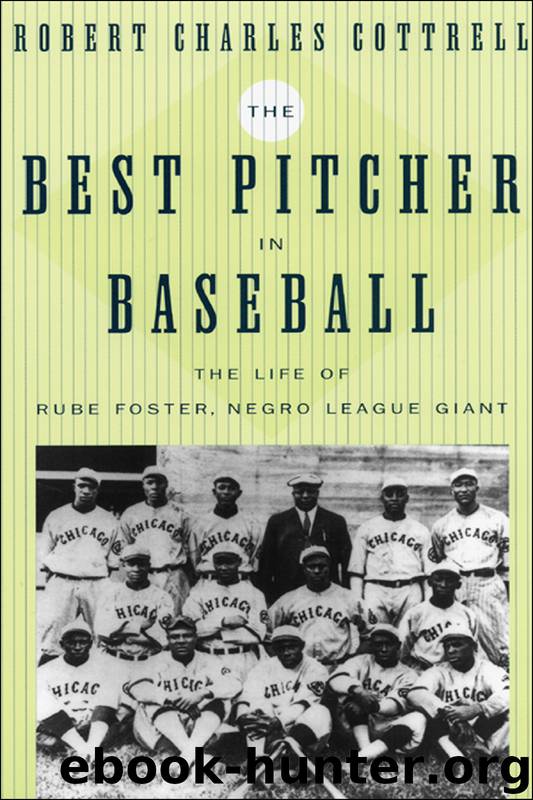The Best Pitcher in Baseball by Robert Charles Cottrell

Author:Robert Charles Cottrell
Language: eng
Format: epub
Publisher: New York University Press
Published: 2001-05-14T16:00:00+00:00
NINE
Rube Ball
The same article in the Defender that proclaimed Rube Foster “a genius” also lauded his system. It was a system that afforded him absolute control of the American Giants’ operations, from the signing of players to the carving out of a schedule. And that system, Foster insisted, enabled his team to remain on top. In 1918, he lost several key players and released John Henry Lloyd, still perhaps black baseball’s finest. Those departures would have proved fatal, he held, “if we had not perfected this system. In so doing we again won the championship, defeated all comers and played better ball this season than the season before.… I cannot get away from the system.”1
By the time the decade neared an end, Foster had honed that system to near perfection. It had enabled the American Giants to follow the path carved out by the Foster-led Leland Giants in being acclaimed the greatest team in black baseball. That very success, of course, continued the championship run Foster had been associated with since he became the ace pitcher for the Cuban X-Giants and the Philadelphia Giants. He, more than any other man in baseball, whether of the blackball or major league brand, was used to winning. Indeed, he was consumed by it. Very seldom a gracious loser, Foster took defeat hard, so it was fortunate that he rarely had to suffer it. As black baseball’s top pitcher during the first decade of the century, Foster had compiled an amazing record, although statistics for his games remain fragmentary. Still a fine pitcher for several additional years into the following decade, Foster’s win-loss pitching mark from 1903 to 1916 stood at a verifiable 152-24-8. He tossed at least four no-hitters, struck out seventeen and eighteen batters respectively in two 1904 games, and amassed an 8-0 record in “colored world championship” contests. In addition, playing in the Cuban winter league, Foster produced an 18-11 record, with his .621 win-loss percentage bettering Frank Wickware’s .600 and Smokey Joe Williams’s .595 figures. Impressive too were the twenty-four complete games, including a league-leading fifteen in 1906, that Foster pitched in the winter circuit. His 170 wins in black baseball and Cuban League competition surpassed the recorded victory totals of his half brother William Foster and Satchel Paige. And that number of wins was undoubtedly no more than half the amount Rube Foster had actually achieved.
Although he was one of the greatest pitchers in the annals of black baseball, Foster’s stewardship of the Leland Giants and Chicago American Giants had proven still more impressive. Through the 1918 season, his teams had either been acclaimed the “colored world’s” titlists or been bested in championship series by squads that were. Both he and others attributed that very success to the Foster system, a top-down approach to guiding his ball clubs that resulted in no brooking of dissent. The players benefited in their own fashion from being part of legendary black baseball teams: they drew the largest salaries among their compatriots, could boast of the sharpest uniforms, traveled in style, and stayed in first-class hotels.
Download
This site does not store any files on its server. We only index and link to content provided by other sites. Please contact the content providers to delete copyright contents if any and email us, we'll remove relevant links or contents immediately.
| African-American Studies | Asian American Studies |
| Disabled | Ethnic Studies |
| Hispanic American Studies | LGBT |
| Minority Studies | Native American Studies |
Cecilia; Or, Memoirs of an Heiress — Volume 1 by Fanny Burney(32436)
Cecilia; Or, Memoirs of an Heiress — Volume 2 by Fanny Burney(31873)
Cecilia; Or, Memoirs of an Heiress — Volume 3 by Fanny Burney(31857)
The Great Music City by Andrea Baker(31374)
We're Going to Need More Wine by Gabrielle Union(18970)
All the Missing Girls by Megan Miranda(15584)
Pimp by Iceberg Slim(14397)
Bombshells: Glamour Girls of a Lifetime by Sullivan Steve(13977)
Talking to Strangers by Malcolm Gladwell(13226)
Norse Mythology by Gaiman Neil(13211)
Fifty Shades Freed by E L James(13158)
For the Love of Europe by Rick Steves(13043)
Mindhunter: Inside the FBI's Elite Serial Crime Unit by John E. Douglas & Mark Olshaker(9206)
Crazy Rich Asians by Kevin Kwan(9170)
The Lost Art of Listening by Michael P. Nichols(7411)
Enlightenment Now: The Case for Reason, Science, Humanism, and Progress by Steven Pinker(7239)
The Four Agreements by Don Miguel Ruiz(6636)
Bad Blood by John Carreyrou(6555)
Weapons of Math Destruction by Cathy O'Neil(6148)
